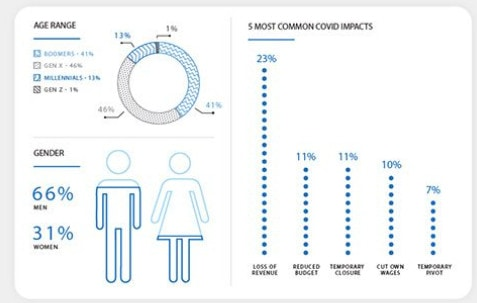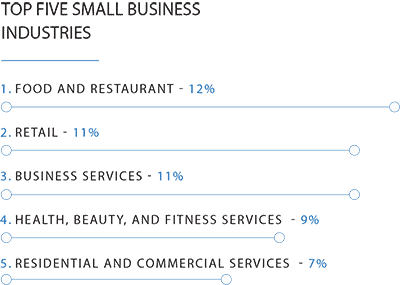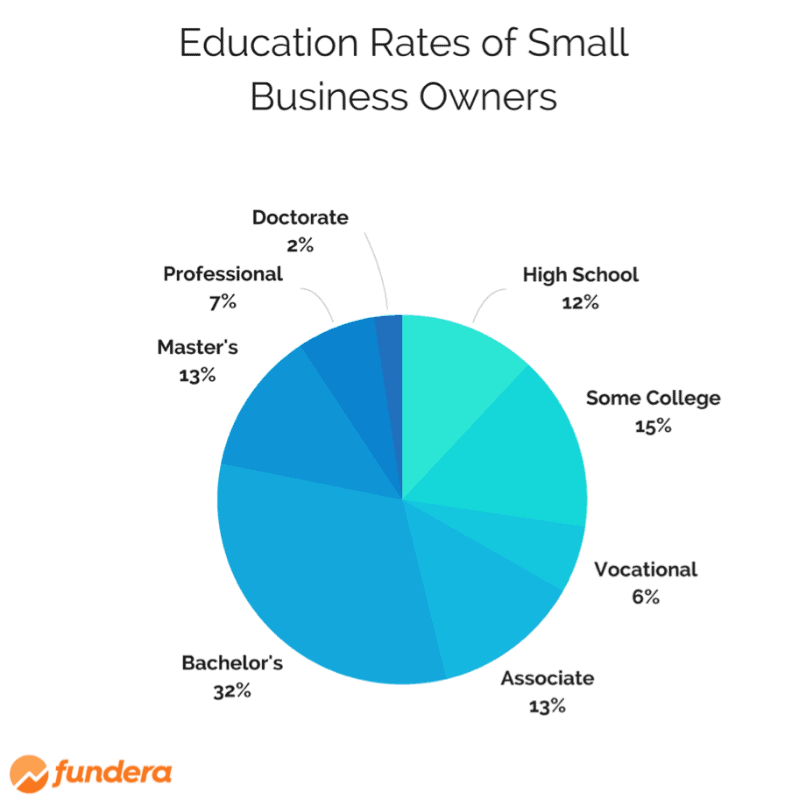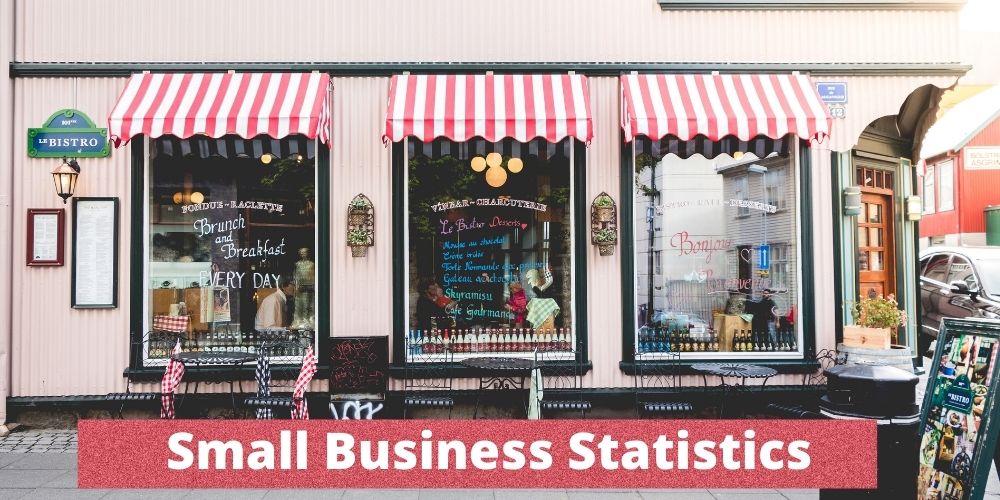How many of you are suffering from stressful meetings at the office?
Are you wishing you could quit your high-pressure job and become your own boss?
There are plenty of people who like to create a small business firm and quit their job.
Business can help control their time and makes them feel content.
Everyone likes to follow their passion but will stop doing so for several reasons. Financial stability is one among them.
If a small business with low investment can help you build your dreams, why not start it today?
Before getting into it, there are some statistics and facts you should know about owning a business.
This article explains the latest small business statistics, facts, and trends in 2024 and the reasons for the success and failure of my busineses.
Post Contents
- 1 Key Small Business Statistics 2024
- 1.1 1. 99% of The American Bsiness Industry Is Owned by Small Businesses
- 1.2 2. 50% of Small Businesses Are Administered from Homes
- 1.3 3. 65% Net New Jobs Created by Small Businesses Since 2000
- 1.4 4. Cash Flow Is the Major Challenge Faced by 28% of Small Business Owners
- 1.5 5. 55% of People Started a Business to Become Their Own Boss
- 1.6 6. 12% of Small Businesses Run without Any Employees Other than The Owner
- 1.7 7. 1.6 Million New Jobs Were Created by Small Businesses in 2020
- 1.8 8. 44% of US Economic Activity Is Controlled by Small Business
- 1.9 9. More than 90% of Businesses Use Facebook to Promote Their Brand, Services, and Products.
- 1.10 10. Only 40% of Small Businesses Are Considered Profitable
- 1.11 11. 31% of Small Businesses Are Severely Affected or Closed Due to COVID-19
- 1.12 12. 20% of New Businesses Close Within Its First Year
- 1.13 13. Average Initial Cost of A Home-Based Business Is Between $2000 and $5000
- 1.14 14. 45% of Small Businesses Have Between 2 – 5 Employees
- 1.15 15. 44% of Small Business Owners Are 39 – 54 Years Old
- 1.16 16. 114% of Small Businesses Were Restaurant Businesses
- 1.17 17. 25% of US Businesses Are Started by Immigrants
- 1.18 18. 19% of Small Business Owners Spend 60 Hours Working in A Week.
- 1.19 19. 43% of People Are Willing to Pay Extra Money on An Item to Support a Small Business
- 1.20 20. 42% of Small Business Fails Due to The Lack of Market Demand
- 1.21 21. 36% of Small Businesses Are Owned by Women
- 1.22 22. 32% of Small Business Owners Have a Bachelors Degree
- 1.23 23. 79% of Small Business Depends upon Digital Platforms to Communicate with Customers
- 1.24 24. 74% of Small Business Owners Are Willing to Take High Risks for Their Firm
- 1.25 25. 52% of Small Businesses Reported that They Face Issues with Labor Quality
- 1.26 26. Around 4.3 Million New Business Applications Were Filed in 2020
- 1.27 27. 0.06% of Growth Recorded in Rural Small Businesses
- 1.28 28. 73% of Small Businesses Depend upon Social Media Marketing
- 1.29 29. 84% of Owners of Small Business Feels Optimistic About the Future of Their Firms
- 1.30 30. Financial Software and CRM Software Are the Leading Technology Priorities for 31% of Small Business
- 1.31 31. 9% of Owners of Small Businesses Are Interested in Selling Their Firm
- 1.32 32. $10,000 Is the Average Minimum Amount Borrowed to Start a Business
- 1.33 33. 58% of Owners Started Their Business from Scratch
- 1.34 34. 56% of Small Businesses Rely on Owners Savings or Loans
- 1.35 35. 30.7% of Business Owners Don’t Take a Salary from Their Firms
- 1.36 36. 77% Funding for Small Businesses Comes from Owners Personal Savings
- 1.37 37. 45% of People Approach Small Businesses to Gain Customized Services
- 1.38 38. 51% of Small Business Has Their Own Websites
- 1.39 39. 27% of Investments Are Made in Establishing the It Infrastructure of The Business
- 1.40 40. 8.5 Years Is the Average Lifespan of A Small Business
- 2 Sources
Key Small Business Statistics 2024
- 99% of the American business industry is owned by small businesses
- 50% of small businesses are run from homes
- 65% net new jobs created by Small Businesses since 2000
- Cash flow is the major challenge faced by 28% of Small Business owners
- 55% of people started a business to become their own boss
- 12% of Small Businesses run without any employees other than the owner
- 1.6 million new jobs were created by Small Businesses in 2020
- 44% of US economic activity is controlled by Small Business
- More than 90% of businesses use Facebook to promote their brand, services, and products.
- Only 40% of Small Businesses are considered profitable
1. 99% of The American Bsiness Industry Is Owned by Small Businesses
According to small business stats, 90 percent of all the businesses in the US are comprised of small and medium enterprises.
They are together known as SMEs.
Based on the studies of Salesforce, SMEs play a vital role in generating employment opportunities in the world.
They contribute to global market innovations and sustainable industrializations.

2. 50% of Small Businesses Are Administered from Homes
Around 70% of Information Technology based startups and SMEs are home-originated.
Home based business statistics show that 60% of enterprises that don’t have employees are based on home.
According to SBA, about 50% of Small Businesses are originated from home.
One of the primary reasons owners prefers home-based enterprises is to ease the initial investment.
For instance, a micro-business can be set up with less than 10 employees with an initial investment of $3000.
However, if the firm is set up based on the home, the expense will come down significantly.
3. 65% Net New Jobs Created by Small Businesses Since 2000
During the third quarter of 2016, almost 240,000 startups were established with 870,000 new job opportunities.
While checking the statistics of the 2020 financial year, more than 1.6 million jobs were created due to small businesses, and such firms showed a growth of 2.1 percent from 2019 to 2020.
4. Cash Flow Is the Major Challenge Faced by 28% of Small Business Owners
Big enterprises are backed by substantial financial support from multiple channels, whereas cash flow is always an issue for startups or home-based SMEs.
Not all firms can produce profit during their hatching period. So funds are required to keep the firm moving until it reaches a self-supporting stage.
Unfortunately, Small Businesses are often funded by their owner’s pocket, and it always faces a cash limit at some point.
Another major challenge faced by business firms is human resource availability and retention.
5. 55% of People Started a Business to Become Their Own Boss
What is the most motivating thing to start a Small Business? There may be several factors, but enjoying the freedom of becoming your own boss is the best explanation.
According to the stats, 29% of owners voted for self-satisfaction when asked this question.
They were either unsatisfied and done by their previous employer, or they never wanted to work under somebody.
Around 17 percent of people started business firms due to dissatisfaction with their current jobs, and 16 percent of the owners who started companies followed their passion.
About 12 percent say the opportunity presented itself in front of them. All they had to do was to follow the trend.
Approximately 7 percent of owners never had any intention to retire from the work-life and started Small Businesses to maintain the flow.

6. 12% of Small Businesses Run without Any Employees Other than The Owner
Sometimes the enterprises are run by the owner itself.
Statistics show that Veterans own around 2.5 million businesses in the US, and more than 2 million of those firms are operated without any employees.
The owner itself can manage small maintenance firms, service-oriented facilities, etc.
7. 1.6 Million New Jobs Were Created by Small Businesses in 2020
Small business facilities are somewhat easy to set up and operate if there are enough funds. On average, it takes only 3-4 days to set up a US startup.
Based on the stats, small firms create many job opportunities every day.
8. 44% of US Economic Activity Is Controlled by Small Business
Almost 90 percent of the world’s business firms fall under SME, and 50 percent of the world’s jobs are created with Small enterprises.
According to the stats of the World Bank, SMEs are the reason for 40 percent of the national income.
Most SME firms rely upon national banks for loans and create an economic flow that indirectly helps the country’s growth.
9. More than 90% of Businesses Use Facebook to Promote Their Brand, Services, and Products.
Nowadays, almost everybody owns a smartphone and social media accounts.
Facebook has more than 2.7 billion followers, making it one of the best platforms for marketing. It is easy to set up a Facebook page for your business.
Facebook offers various packages to promote your business sales that target locations and customers.

10. Only 40% of Small Businesses Are Considered Profitable
Although certain service-oriented startups are profitable, most SMEs are not so financially successful.
According to the statistics, only 40% of small businesses are considered profitable.
Some of the least profitable industries include oil and gas extraction, beverage manufacturing, forging and stamping, software publishing, etc.
11. 31% of Small Businesses Are Severely Affected or Closed Due to COVID-19
The latest statistics from Facebook say 31 percent of the business startups based in the US are currently not functional due to the Covid-19 pandemic.
The lockdown period and related restrictions affected the functioning of small businesses, and almost 70 percent of services got shut down in March 2020.
Around 51 percent of firms tried to be active by providing online services through the internet.
They were able to retain many clients, and due to the direct interactions and customer-friendly sessions, such companies gained positive customer feedback.
Almost 36 percent of personal businesses that connected with customers online started providing online sales as well.
12. 20% of New Businesses Close Within Its First Year
Due to the lack of product/ service demand, around 20 percent of the businesses close within their first year of existence.
Even though such firms are started with good planning, they lack a progressive methodology in between, which may cost them lose the market.
Sometimes, unexpected situations that arise in the business world can also be the reason for the early death of small firms.
Some business setups are affected by the lack of talented employees and innovative types of equipment by which the company fails to meet the expected growth.
13. Average Initial Cost of A Home-Based Business Is Between $2000 and $5000
Approximately, there are 15 million home-based small firms in the US which is almost half the total number of small businesses.
Since the home is the headquarters or central office of the business, much money is saved in rent.
Online boutiques, accounting firms, etc., are some examples of home-based business setups.
The average cost for setting up a home-based business comes between $2000 and $5000.
14. 45% of Small Businesses Have Between 2 – 5 Employees
Small firms generally are lazy to appoint employees if a single person can handle the services. However, restaurants, retail shops, etc., need 2 or more employees to work.
Stats says that around 45% of Small Businesses have between 2 – 5 employees.
15. 44% of Small Business Owners Are 39 – 54 Years Old
The movie shows young entrepreneurs who acquire success in their businesses.
So how similar is it with the reality? Actually, it is not!
A survey conducted by Experian shows that an Average American small firm owner is 50 years old.
The construction firm owners are considered the youngest, with 48 years old on average.
Financial enterprises, insurance firms, real estate businesses, etc., have the most average aged owner, which falls between 52-55.

16. 114% of Small Businesses Were Restaurant Businesses
It is one of the most popular industries for small businesses that people would like to invest their money in.
Restaurant businesses require much more investment when compared to home-based firms and service-oriented businesses.
It needs a physical outlet that can accommodate at least 10 people at a time, a good chef who can understand the taste of the locality, and some attendants who can take orders, serve food and clean the table.
However, restaurant businesses were severely affected by the Covid-19 pandemic.
According to the statistics of The National Restaurant Association, about 100,000 restaurants were closed during the first 6 months of the Covid-19 pandemic.
Those restaurants that offered online delivery services with attractive prices could profit during the period.

17. 25% of US Businesses Are Started by Immigrants
American community survey suggests that 13 percent of the population are immigrants, and immigrants own 25 percent of the small enterprises.
According to small business statistics and data, immigrants work on about 65 percent of taxies, 53 percent of gas stations, and 54 percent of dry cleaning and laundry firms.
The survey also found out that about 14 percent of the private sector employment is covered by immigrants who contributed $776 billion to the country.
Most of them are part of the professional services followed by construction, education, social services, hospitality, and retail sectors.
18. 19% of Small Business Owners Spend 60 Hours Working in A Week.
It is estimated that a small firm owner spends more than 9 hours a day working for 7 days a week.
Since most SMEs lack the additional employee count, the firm owner has to take care of multiple tasks to maximize profit.
Based on the stats, 19% of Small Business owners spend 60 hours working weekly.
19. 43% of People Are Willing to Pay Extra Money on An Item to Support a Small Business
Sometimes people do great things. According to a study in the US, it was found that 43% of people are willing to pay extra money on an item to support a Small Business.
Most small firms are locality specific, and people in the locality try to pay extra for the product/services provided by the firm.
20. 42% of Small Business Fails Due to The Lack of Market Demand
Most of the small enterprises shut down during the first few years of their existence.
Along with many other reasons, 42% of Small Business fails due to the lack of market demand.
So customers will try to buy things from such distributors. Sometimes the same product or service will be available from another distributor with a better deal.
Small enterprises have to be innovative, and they should foresee the future of their market evolution. Else the end will be far sooner than expected.
21. 36% of Small Businesses Are Owned by Women
According to the statistics, women-owned businesses have a 5 percent growth rate and generate around 1.9 trillion dollars per year.
African countries show significant growth in women-owned businesses.
Women control around 46 percent of private businesses in Ghana, and they also own 30 percent of home-based businesses in Uganda and Vietnam.
California has the highest number of women entrepreneurs in the US, which is 1.3 million.
Statistics say that women launch more than 1,200 new businesses every day in the US.

22. 32% of Small Business Owners Have a Bachelors Degree
About 15 percent of business owners have college experience. Still, not everyone has completed their studies, while 32 percent have a bachelor’s degree.
13 percent of the entrepreneurs have a master’s degree, and 7 percent have a professional degree.

23. 79% of Small Business Depends upon Digital Platforms to Communicate with Customers
Digital platforms for customer relations management, automated assistance, etc., can help small firms to avoid plenty of unwanted yearly expenses.
Most of the small enterprises have set up interactive customer platforms as part of their website to answer questions from the customers.
Usually, there will be a frequently asked questions section to help customers understand the solution and clarify their doubts.
However, studies have shown that customers are more interested in interacting with humans than chatbots and pre-trained algorithms.
24. 74% of Small Business Owners Are Willing to Take High Risks for Their Firm
Most small enterprises generate low profits during their primary stage of growth.
However, firm owners who are new to business have a tendency to invest a huge amount in various sections such as sales and marketing, employee retention, etc.
They favor avoiding the statistical facts that concern the firm’s growth and believe in the probability of miracles even though they are currently under loss.
25. 52% of Small Businesses Reported that They Face Issues with Labor Quality
Small business trends tell us that the advantage and disadvantage of small enterprises are their employees.
On the positive side, no more than 4-5 employees are required for a small to medium business setup.
Hence it is crucial to identify the best employees required for the job and monitor their performances occasionally from the customer point of view.
However, if the employees are not showing quality, the business will not withstand the competition without question.
Once customers feel like your firm delivers poor-quality products or services, they will stop buying things from your business and move on to the next shop.
26. Around 4.3 Million New Business Applications Were Filed in 2020
Even though the Covid-19 has shattered the small firms, the market saw shocking statistics of new business applications by the end of 2020.
There were 4.3 million new business applications filed in 2020. The business market expects 3 times more than the count in 2021.
27. 0.06% of Growth Recorded in Rural Small Businesses
Rural small enterprises face many challenges like transportation issues, insufficient energy, human resources, raw materials, etc.
They cannot create products or services that cost beyond the price that customers in a rural area can afford.
The latest small business statistics show that rural area small scale business firms recorded 0.06% of growth during the last year.
However, enterprises in metropolitan counties have grown by 1.9 percent during the same time.
28. 73% of Small Businesses Depend upon Social Media Marketing
Social media marketing, termed digital marketing, is the latest trending method to reach maximum customers.
The wide availability of smartphones, increase in internet speed, and current Covid-19 pandemic have created a virtual business world where everything is bought and sold online.
Since most of the young generation is spending their time on smart devices and social media, enterprises have begun to concentrate their marketing techniques on social media platforms.
Facebook, Instagram, Youtube, etc., are some of the most used social media platforms for business advertisements.
The major benefit of advertising through these social media platforms are they are very cheap compared to the traditional advertising methods.
29. 84% of Owners of Small Business Feels Optimistic About the Future of Their Firms
Small business owners are mostly newbies to the industry with very little knowledge in selling products and services.
Hence, instead of calculating and predicting the next few years’ business markets for their firm, most of them hope that their business will flourish despite the current market trend.
30. Financial Software and CRM Software Are the Leading Technology Priorities for 31% of Small Business
Based on the Salesforce survey, small firms have focused on automated financial softwares and customer relationship management tools to avoid appointing employees to the firm.
Even though the initial costs of implementing such software tools may be a bit high, they can save thousands of dollars for the business owner per month if executed correctly.
Around 28 percent of the business firms prioritize technology services.
31. 9% of Owners of Small Businesses Are Interested in Selling Their Firm
Even though the small firms are not yielding huge returns and face loss at the initial stages, around 51 percent of the owners are interested in implementing various factors that help grow their business.
Statistics show that 30 percent of business owners like to stick with current companies.
In comparison, 10 percent are interested in opening new business branches in new locations to expand it.
However, due to loss and lack of resources, about 9 percent of Small Businesses are interested in selling their firm.
32. $10,000 Is the Average Minimum Amount Borrowed to Start a Business
According to SBA, the average loan amount for all businesses in 2018 was $663,000 regardless of the loan type.
The loan amount can vary from $10,000 to $1.2 million, depending upon the financial requirement.
However, it is advised to take a low-interest loan or low loan amount during the business’s initial time.
33. 58% of Owners Started Their Business from Scratch
Most small businesses are service-oriented and require significantly less investment.
Hence it is easy to start them from scratch compared to the expenses of acquiring an already established one.
However, it is better to buy a small firm if its name is already famous in the locality.
The publicity earned firms doesn’t need more marketing works as the locality will spread the word!
According to the stats, around 18 percent of small firms are acquired from one party to another.
34. 56% of Small Businesses Rely on Owners Savings or Loans
Based on a study conducted by Federal Reserve Banks of various states, 54 percent of owners depend upon personal loans, and 53 percent stay with credit cards.
Since most small firms don’t require a massive investment, such traditional loans are enough to start a business.
Around 30 percent of startups that don’t have employees and 7 percent of firms with employees started the business without any capital investment.
35. 30.7% of Business Owners Don’t Take a Salary from Their Firms
Small business revenue statistics indicate that small businesses need a significant amount of time to grow back the invested amount.
So the initial returns during the first few years of the business cannot be considered as revenue.
Business owners use that money to repay and close loans with huge interests and cover monthly expenses like rent, the salary of employees, etc.
Around 86.3 percent of owners get an annual salary of $100,000 or less, and around 30.7 percent of them don’t take the salary at all.
36. 77% Funding for Small Businesses Comes from Owners Personal Savings
According to the statistics, 34 percent of funds for small firms are accumulated with the help of bank loans.
Around 16 percent of funds are created by the help and support of family and friends and approximately 4 percent from online lenders.
About 3 percent of People choose Angel investors or Venture capital to raise investment funds, while 2 percent depend upon Crowdfunding.
37. 45% of People Approach Small Businesses to Gain Customized Services
Most people choose small enterprises to get a customized product.
A cloth retailer in the locality may be able to stitch you a shirt according to the designs specified, while such benefits may not be available with large companies.
38. 51% of Small Business Has Their Own Websites
Surprisingly, about half of the small firms are still working traditionally where websites are the most minor requirement.
Small business owner statistics show that around 24 percent of business owners admitted that they don’t know how to set up and maintain a website.
While the owner runs most firms, a website is an unwanted expense if people do not check it online.
Lack of enough funds is also one of the reasons for not having a website.
39. 27% of Investments Are Made in Establishing the It Infrastructure of The Business
Almost 49 percent of the business owners are thinking about increasing their staff and expanding their infrastructure.
Around 55 percent of the small company management plans to invest their time and marketing money on digital media, while 30 percent are still interested in traditional marketing methods.
And 22 percent of firms invest in third-party services such as accounting software, inventory management, etc.
40. 8.5 Years Is the Average Lifespan of A Small Business
Small business statistics show that the average lifespan of a small business is just 8.5 years.
Almost 550,000 small firms end their life in a year.
Statistics show that about half of the small companies stay in the market for five years or more, and about a third of them can overcome the consequences and withstand unpleasant situations.
Such companies can survive longer.






























